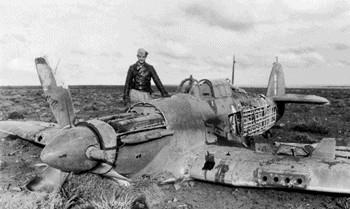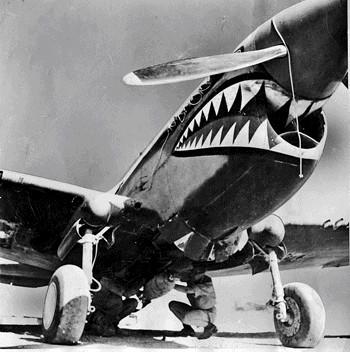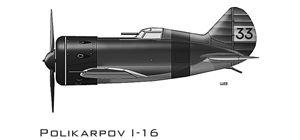Lords of the Sky: Fighter Pilots and Air Combat, From the Red Baron to the F-16 (22 page)
Read Lords of the Sky: Fighter Pilots and Air Combat, From the Red Baron to the F-16 Online
Authors: Dan Hampton
Tags: #History, #United States, #General, #Military, #Aviation, #21st Century

A German Me 262, the first operational jet fighter. Though revolutionary, too few were produced, too late in the war, to make a measurable impact.

German ace Hans-Joachim Marseille, nicknamed “The Star of Africa” for his exploits in North Africa.
(Library of Congress)

Marseille examines a British Hurricane he shot down, one of more than 150 total victories.

Marseille stands by as his fiftieth kill is recorded on his tail.

In Libya a British mechanic hooks up a bomb to the belly of an American-built P-40.
(The collection of Peter Hubbard)
IN THE LAP OF THE GODS:
1919–1939
I
T IS FINISHED, AND, AS NO ONE IS SATISFIED, IT MAKES ME
HOPE WE HAVE MADE A JUST PEACE; BUT IT IS ALL IN THE LAP OF THE GODS
.
—
PRESIDENT WOODROW WILSON, JUNE 1919

These, in the day when heaven was falling,
The hour when earth’s foundations fled,
Followed their mercenary calling,
And took their wages, and are dead.
Their shoulders held the sky suspended;
They stood, and earth’s foundations stay;
What God abandoned, these defended,
And saved the sum of things for pay.
—A. E. HOUSMAN, “EPITAPH ON AN ARMY OF MERCENARIES”
THE GREAT WAR
was over, but the world was far from peaceful.
Russia was convulsed in a desperate struggle that would have extreme consequences for the next seven decades. The provisional government replacing the tsar had collapsed in early 1918, leaving two main factions vying for control. The “Reds” were Bolsheviks, led by Lenin, and they controlled much of the populated areas as well as most of the industrial centers—a key advantage in a civil war, where popular support was critical. They were opposed by the “Whites,” remnants of the monarchists, aristocratic upper classes, and many former military officers.
By 1919 White Russian forces controlled a great deal of the agricultural territory in the middle of the country with the notable exceptions of St. Petersburg and Moscow. With much better leadership, they also enjoyed widespread support from Japan, the United States, and Great Britain.
*
In April of that year, 47 Squadron RAF arrived at Novorossiysk on the Black Sea to assist Gen. Anton Denikin’s White Volunteer Army. A combat corps commander from World War I and former chief of staff, Denikin was advancing north along the Volga toward Moscow.
The RAF squadron was commanded by none other than Raymond Collishaw (see Chapter 4), whose Black Flight of Sopwith triplanes had caused so much mayhem over the Western Front in 1917. Now a lieutenant colonel, Collishaw had been sent to augment the official RAF training mission in Russia. They were supposed to be merely instructors, teaching Russian pilots to fly the RE-8, but that changed rapidly.
As the British Empire’s third-ranked ace, having finished the war with sixty victories, Collishaw took command of a squadron containing DH-9s and Sopwith Camels. Collie, a fighter pilot to the core, had an incentive program for his pilots that went like this: The first pilot to shoot down a “Bolshie” plane was entitled to the first Russian princess they found, while the man who received the first medal (of any type) got the first duchess. Additional kills and medals entitled the winners to additional princesses and duchesses. There was also a liquor ration, since there was enough “ale, beer, Scotch, brandy, rye and vodka for a regiment of the Royal Irish.” Caviar, vodka, beautiful girls, and a war—what fighter pilot could want more?
By late June, Collie was back in combat, bombing boats and railroads and, above all, strafing Red troops. The steppes were ideally suited to fast-moving horsemen, so—unlike on the Western Front—cavalry played a tremendous role in the Russian campaign. They were opposed by a Red air force of Nieuports, SPADs, and Fokkers flown largely by a mixed bag of mercenaries left over from the Great War.
During the crucial battle for Tsaritsyn, Red cavalry under Boris Dumenko was attacked and shredded by 47 Squadron’s B Flight and its Camels.
*
Routed and disoriented, the survivors were then cut to pieces by White Cossacks. Led by a South African named Samuel “Kink” Kinkead, a thirty-two-victory ace of the Great War, the four Camels killed more than a thousand Bolsheviks with their twin Vickers guns.
This would become a viable and effective tactic: a shocking, surprise air attack followed by the coup de grâce of a charge and flashing sabers. A curious blending of ancient horse-borne weaponry with the devastation of aircraft, it worked largely because the steppes were wide, flat, and offered little cover.
Interestingly, one of the B Flight Camel pilots was an American. Son of a Texas Ranger, Marion Aten had made his way to England and joined the Royal Flying Corps in 1917. Finishing flight training the day after the armistice was signed, Aten would stay with 47 Squadron for the duration of the conflict, then go on to fight in Iraq. There were other Yankees who had fought during the previous year at Arkhangelsk. The American Expeditionary Force Siberia was also active, protecting U.S.-supplied equipment in the east, but in both cases there was little air involvement.
For his assault on Moscow, General Denikin decided to use a three-pronged attack. This had the advantage of tying up large concentrations of Red troops, but it also left his own lines dangerously extended. The Red Army needed reorganizing, and had been reformed with Leon Trotsky as war commissar. Unfortunately, the Bolsheviks had bolstered their numbers with tens of thousands of dispossessed peasants and returning soldiers. Thousands of ex-tsarist officers rejoined the army, reacting with a typical Russian xenophobia toward foreigners that Trotsky quickly exploited. The Bolsheviks had also been joined by the Black Army (Revolutionary Insurrectionary Army of Ukraine), and their combined forces soundly defeated the Whites at Orel in October 1919.
If Denikin had won at Orel, the White Army would have marched on Moscow. If the city had fallen in 1919, the Bolsheviks might well have been defeated and the Soviet Union would never have existed. How different would the rest of the century have been with no Russian Communist threat to work against?
But Denikin was forced to fall back, and the pilots went with him. Collishaw himself had contracted typhus and didn’t get back in action until the end of November 1919. Part of the fighting retreat to Rostov, 47 Squadron flew close air support missions against Red cavalry, railroads, and boats on the Volga River. Collie’s DH-9s made it to the Crimea in January 1920 and began flying from an aerodrome near Djankoi. During one such sortie, he was hit by ground fire and made an emergency landing in enemy territory. The engine was still gasping and wheezing, so, rather than walk, Collie taxied the wounded bird some 20 miles through the snow to safety.
B Flight eventually made it back to Novorossiysk but had to destroy their battered Camels in the face of the advancing Bolsheviks. Using a tank, they flattened the planes, and then did the same to forty new DH-9 two-seaters still crated on the docks. Late in March they sailed for Constantinople, and Marion Aten wrote later that:
the waterfront was black with human beings. A solid mass of people covered the shore, the quay, the piers, the mole and the breakwater. As we left the train and started towards the ship the refugees pressed around us, shrieking, begging, imploring . . . a mob of desperate refugees suddenly rushed the steamer gangplank and machine guns on the deck cut loose. Ten men and women fell, twenty, thirty, and I could watch no more.
Collie and the rest of his squadron also escaped to Turkey. He would go on to command 84 Squadron in Egypt, then be sent on to Persia. Knighted in 1921, Raymond Collishaw commanded Number 5 Wing during the Second Italo-Abyssinian War in 1936 and remained in the RAF through World War II. Marion Aten would also continue flying and traveled to Iraq after Russia. He survived and in 1927 retired to the family ranch in California. General Denikin relinquished command to Baron Wrangel and fled to Paris, where he lived as a writer until the city fell in 1940. Denikin died in Ann Arbor, Michigan, in 1947.
ATROCITIES ON BOTH
sides of the civil war were widespread and horrific. The Red Army carried out anti-Jewish pogroms, and the White Cossacks were infamous for their rapine and plunder. In the end, popular support swung to the Bolsheviks, and this turned the tide. The old tsarist regime represented by the Whites was hardly a stirring memory for most Russians, and Red propaganda was particularly effective in exploiting this.